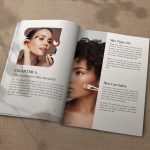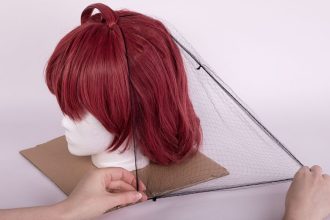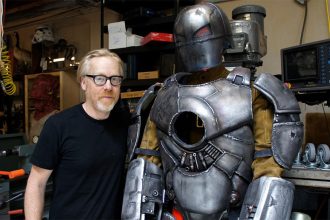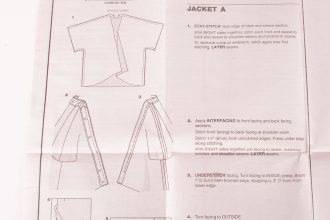Intro: EVA Foam as the Beginner’s Best Friend
For newcomers to armor crafting, the world of cosplay prop making can seem overwhelming with its array of materials, tools, and techniques. However, there’s one material that stands out as the perfect starting point for beginners: EVA foam. This versatile, forgiving, and budget-friendly material has become the “wonder material” of armor making for good reason, offering an ideal balance of ease of use and professional results.
EVA foam (Ethylene Vinyl Acetate) is a lightweight, closed-cell foam that’s commonly found in craft stores and online as both floor mats and craft sheets. Its unique properties make it perfect for cosplay armor – it’s easy to cut, shape, and paint, yet durable enough to withstand convention wear and transport. Best of all, it’s incredibly forgiving of mistakes, allowing beginners to learn techniques without the fear of ruining expensive materials.
Choosing Your Foam: Understanding the Options
Not all EVA foam is created equal, and understanding the differences between available options will help you select the right material for your project. The two main types you’ll encounter are foam floor mats and high-density craft foam rolls, each with distinct characteristics that make them suitable for different applications.
Foam Floor Mats: The Budget-Friendly Option
Foam floor mats are an excellent choice for beginners due to their availability, affordability, and thickness options. These mats typically come in 2’x2′ or 3’x5′ sections with thicknesses ranging from 1/4″ to 1/2″. They’re widely available at home improvement stores, online retailers, and even some department stores.
Advantages of foam floor mats:
- Very affordable, especially when purchased in bulk
- Available in multiple colors, reducing the need for painting
- Thick enough for substantial armor pieces
- Easy to cut with basic household tools
- Readily available in most locations
When selecting floor mats, look for options labeled as “EVA foam” rather than generic “foam” to ensure you’re getting the right material. Avoid mats that feel too soft or spongy, as these may not hold their shape well for armor applications. Popular color options for cosplay include black, white, gray, and brown, which can be easily painted to match character designs.
Pro Tip:
Many crafty cosplayers save money by purchasing foam floor mats during sales at home improvement stores. Black Friday and end-of-season clearances often offer significant discounts on these materials. You can also check with local gyms or martial arts studios, as they sometimes have excess mats they’re willing to sell cheaply.
High-Density Craft Foam Rolls: The Professional Choice
High-density craft foam rolls are specifically designed for crafting applications and offer superior quality compared to floor mats. These rolls typically come in thicknesses from 1/8″ to 1/2″ and are available in large sheets that provide more working area. They’re usually found in craft stores and online specialty suppliers.
Advantages of high-density craft foam:
- More consistent thickness and density
- Better surface finish for painting
- Available in thinner options for detailed work
- Easier to achieve smooth curves and shapes
- Better durability for frequently worn pieces
While more expensive than floor mats, craft foam rolls offer better results for detailed work and pieces that will see heavy use. They’re particularly valuable for creating clean edges and smooth surfaces that require minimal preparation before painting. For your first armor project, either option will work well, but craft foam may provide a more professional finish with less effort.
Where to Buy EVA Foam in Qatar
Fortunately for Qatari cosplayers, EVA foam is readily available from several sources, both online and in physical stores. Knowing where to find quality materials at reasonable prices will save you time and money as you build your cosplay armor collection.
Recommended purchasing options in Qatar:
- Home Depot and similar home improvement stores for foam floor mats
- Craft stores like Michael’s or local art supply shops for craft foam rolls
- Online retailers like Amazon.ae or Noon for bulk purchases
- Specialty cosplay suppliers who may offer imported materials
- Local Facebook groups and marketplace for community-sourced materials
When ordering online, pay attention to shipping costs and delivery times, especially if you’re working on a convention deadline. Many community members have found good deals by pooling orders with other cosplayers to reduce shipping costs per person. Our community forum has a dedicated buying and selling section where members often share information about good deals and reliable suppliers.
The Essential Toolkit: Basic Tools for Foam Crafting
One of the appealing aspects of EVA foam crafting is that you can start with a minimal toolkit and gradually expand your collection as your skills develop. The basic tools required for foam crafting are relatively inexpensive and can be found at most hardware or craft stores, making this hobby accessible to cosplayers on any budget.
Cutting Tools: Precision and Control
Sharp, clean cuts are fundamental to professional-looking foam armor, and having the right cutting tools makes all the difference in achieving clean edges and accurate shapes. While you can technically cut foam with many tools, some are far more effective and safer than others.
Essential cutting tools include:
- Sharp utility knife with extra blades – The workhorse of foam cutting
- Craft knife with fine blade – For detailed work and curves
- Straightedge or ruler – Essential for clean, straight cuts
- Cutting mat – Protects surfaces and provides measurement guides
- Scissors for fabric and thin foam – Useful for certain applications
A quality utility knife is perhaps your most important investment, as dull blades will tear foam rather than cut it cleanly. Always use extra blades and change them frequently – a sharp blade is safer and more effective than a dull one. When cutting, use a slow, steady motion and make multiple light passes rather than trying to cut through thick foam in one go.
Shaping Tools: Heat and Form
While EVA foam can be cut into flat shapes, its real potential emerges when you use heat to shape it into three-dimensional forms. The right heating tools allow you to create curves, angles, and complex geometries that bring your armor designs to life.
Essential shaping tools include:
- Heat gun – The primary tool for foam shaping and activation
- Hair dryer (as backup) – Less precise but adequate for beginners
- Foam-safe sandpaper – For smoothing and texturing surfaces
- Wooden dowels or shaping tools – For creating curves and details
Safety First:
When using heat tools, always work in a well-ventilated area and keep a fire extinguisher nearby. Never leave a heat gun unattended, and be aware that overheated foam can produce toxic fumes. Start with lower heat settings and increase gradually as needed – it’s better to apply heat multiple times than to overheat and damage your piece.
Assembly Tools: Bringing Pieces Together
Once you’ve cut and shaped your foam pieces, you’ll need tools to assemble them into complete armor components. The right adhesives and fasteners ensure that your pieces stay together during wear while maintaining a professional appearance.
Essential assembly supplies include:
- Contact cement – Strong, flexible adhesive for foam-to-foam bonding
- Hot glue gun – For temporary positioning and quick fixes
- Wood glue – For attaching wooden supports or dowels
- Clamps or weights – To hold pieces during adhesive curing
- Sewing pins or T-pins – For temporary positioning during assembly
Contact cement is the gold standard for foam assembly, creating strong bonds that remain flexible enough to withstand movement and temperature changes. Apply adhesive to both surfaces, allow it to become tacky, then press the pieces together firmly. For best results, use clamps or weights to hold pieces in position while the adhesive fully cures.
Tutorial: Your First Bracer
Now that you understand the materials and tools, it’s time to put theory into practice with a simple but effective project: a basic forearm bracer. This project will teach you fundamental techniques including pattern creation, cutting, shaping, and assembly while producing a wearable piece that you can be proud of.
Pattern Creation and Measurement
Every successful foam project begins with accurate measurements and a well-designed pattern. For your first bracer, you’ll need to measure your arm and create a simple pattern that can be easily transferred to foam.
To measure for your bracer:
- Measure the circumference of your forearm at its widest point
- Measure the length from wrist to elbow (or desired bracer length)
- Add 1 inch to circumference for comfort and overlap
- Sketch a rectangular pattern on paper with these dimensions
- Add 1/2 inch to all sides for seam allowances
For a simple design, your bracer pattern can be a basic rectangle with rounded corners. As you gain experience, you can add decorative elements like scallops, points, or geometric patterns. Keep your first project simple to focus on mastering the fundamental techniques.
Cutting and Basic Shaping
With your pattern ready, it’s time to transfer it to foam and begin cutting. This step requires patience and attention to detail, as clean cuts will make all subsequent steps easier and produce a more professional result.
Cutting process:
- Place pattern on foam and trace around it with a pencil
- Cut slightly outside the traced line to allow for sanding
- Use long, smooth strokes with your utility knife
- Make multiple light passes rather than pressing hard
- Sand edges smooth with fine-grit sandpaper
After cutting, use the edge of your knife or a sanding block to bevel the edges slightly. This creates a more professional appearance and helps the bracer conform to your arm’s shape. Beveling also makes painting easier by eliminating sharp edges that can collect paint unevenly.
Adding Details and Texture
While your basic bracer shape is functional, adding details and texture will make it visually interesting and more authentically armor-like. These details can be as simple or complex as you wish, but even basic texturing can dramatically improve your piece’s appearance.
Simple detailing techniques:
- Use a pencil or stylus to create panel lines
- Cut small V-shaped grooves for recessed details
- Add texture with sandpaper or specialized tools
- Create rivets using small ball bearings or clay
- Cut geometric shapes from contrasting foam colors
For your first project, try creating simple panel lines by lightly scoring the foam surface with a craft knife. These lines should be shallow – just enough to create shadows when painted. You can also add a few “rivets” by gluing small ball bearings or pieces of wooden dowel to the surface for added detail.
Assembly and Finishing
The final steps involve assembling your bracer into a wearable piece and preparing it for painting or decoration. Proper assembly ensures comfort and durability, while finishing preparations make the painting process easier and more effective.
Assembly process:
- Cut a strip for the closure overlap (1-2 inches wide)
- Attach closure strip with contact cement
- Sand all surfaces smooth with fine-grit sandpaper
- Wipe clean with damp cloth to remove dust
- Apply primer if planning to paint
For closure, you can use Velcro strips, snaps, or even elastic bands depending on your design preferences. Attach the closure material before final assembly to ensure proper positioning. Once assembled, give your bracer a final sanding to smooth any rough spots and create a uniform surface for painting.
Conclusion: Start Small and Build Your Skills
Completing your first EVA foam bracer is a significant milestone that demonstrates your ability to transform simple materials into wearable costume pieces. This foundational project teaches essential skills that will serve you well in all future foam crafting endeavors, from simple accessories to complex full-body armor sets.
Don’t be discouraged if your first attempt isn’t perfect – even experienced foam crafters still learn new techniques and occasionally make mistakes. The beauty of EVA foam is its forgiving nature, which allows for corrections and improvements as you work. Take pride in what you’ve accomplished and use it as motivation to tackle more ambitious projects.
As you continue to develop your foam crafting skills, consider attending one of our community workshops on sealing and painting foam, which will be the natural next step in your armor-making journey. Our experienced members are always willing to share tips and techniques, and seeing others’ work can provide inspiration for your future projects.
Remember to celebrate your first creation – wear it with pride at your next convention or community event. Your successful completion of this tutorial proves that you have the skills and determination to bring even the most ambitious cosplay visions to life through foam crafting. The only limit is your imagination.









